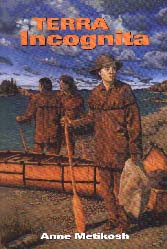|
________________
CM . . . .
Volume VII Number 13 . . . . March 2, 2001
excerpt: One night as she teetered on the edge of sleep, a haunting cry suddenly jerked her back to wakefulness. It sounded at first like a dog, with an odd staccato bark. The howl built to a melodic high note, and then, as it trailed off, another answered, then two or three more. It reminded Madeleine of the trumpets used to call soldiers to arms, and it filled her with a nameless dread. She thought of her mother's stories of Ile des Demons. Safe in her bed in Paris, she had dismissed the echoing wails as the cries of animals. But what animal on earth made such a sound as this?Filled with tantalizing "sound bites" of early Canadian history, this novel follows the geographical and maturational voyages of Madeleine Hebert, a 15-year-old girl who travels from Paris, France, with her older brother Philippe to Quebec and beyond in 1670. Madeleine has always been captivated by her mother's stories of the New World where her father has spent so much of his time and is residing at the present. Her favourite is that of Marguerite de Roberval's tragic sojourn on the Ile des Demons in Newfoundland. Madeleine resolves that she would never let her female identity stop her from experiencing great adventures. Soon after the death of their mother, Philippe and Madeleine embark on the first leg of their journey to bring this devastating news to their father in New France. Upon their arrival in Quebec, they discover that their father lies wounded at Michilimackinac, a trading fort on Lake Michigan. Philippe and Madeleine travel to the small community of Montreal where Philippe makes arrangements for Madeleine to stay while he travels with Gabriel, one of the coureurs de bois who regularly travel between the two communities. Philippe is not prepared for Madeleine's reaction. She is not going to miss a chance for a grand adventure! Although he is dismayed at the idea of her traveling with a "rough bunch of guys," she soon persuades Philippe to take her along, disguised as his younger brother Martin (the name of Marguerite de Roberval's lover). The majority of the novel focuses on the canoe trip with Gabriel between Montreal and the fort. Martin cuts her hair short and claims to be 13, and her need for privacy is assured by Philippe's assertion of his brother's recent and strange illness. The scenery and hardships encountered are, for the most part, successfully brought alive for the reader. The story takes a turn when they find Andre, a friend of Gabriel's, who has been assaulted and robbed of his trading goods but left with his canoe. They take him to a nearby Huron village where Madeleine discovers Gabriel's heritage. After three days, the three voyagers travel the final hundred miles where the siblings are soon reunited with their father who is in charge of the fort. Gabriel is not received with the same enthusiasm but soon redeems himself by saving Madeleine from attack and by becoming a businessman instead of an outlaw. I particularly applaud the scene where, fed with warnings about dangerous bears, Madeleine has her first sighting of these fierce animals. The reader, however, realizes that what she is describing is a moose. It is these small details that give the story authenticity. But there are many instances within the text that do not add a realistic voice. I was jarred out of the story when Madeleine referred to herself as a sightseer (p. 43). The word came into being approximately 150 years after this story takes place. On a personal note, as well, I wonder how Madeleine and Philippe managed not to suffer from blisters with all the paddling they had to do during the trip. For much of the story, this is another example of a modern heroine in historical costume. However, much of the description (which young readers may skim over) gives a realistic picture of early Canada. Recommended with Reservations. Gail de Vos teaches at the School of Library and Information for the University of Alberta and, as resident storyteller, brings history alive through stories at Fort Edmonton Park.
To comment on this title or this review, send mail to cm@umanitoba.ca.
Copyright © the Manitoba Library Association.
Reproduction for personal use is permitted only if this copyright notice
is maintained. Any other reproduction is prohibited without
permission.
Published by
TABLE OF CONTENTS FOR THIS ISSUE - March 2, 2001.
AUTHORS |
TITLES |
MEDIA REVIEWS |
PROFILES |
BACK ISSUES |
SEARCH |
ORDER |
CMARCHIVE |
HOME
|
